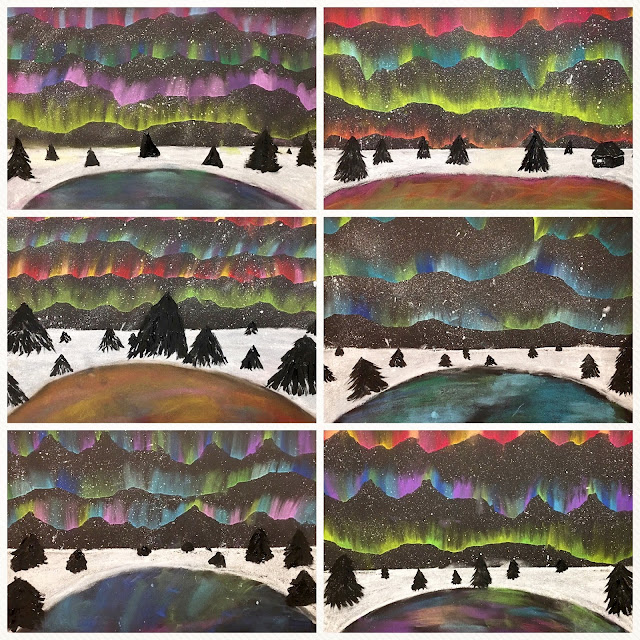There are many different ways to produce the aurora lights using chalk, but I opted for this method, which I discovered through my Instagram art teacher community. I have artwithmrs.e. to thank for posting about this cool method. See below.
Method:
The first thing we did, of course, was watch a youtube video about the Auroras. There are tons of very complicated video explanations out there, but I found this one to be kid-friendly enough to present to my 6-13 age range of students.
We then splattered white tempera paint on our black paper using toothbrushes.... the kids always ask if I've ever brushed my teeth with these. Maybe, maybe not.
We covered the bottom half of our black paper top to prevent the stars from splattering all over our paper.... because well, stars are only in the sky, not below our horizon line.
Then we got to work on our chalk auroras.
We tore paper strips into uneven and changing shapes. I had the kids aim for mountain ranges. My younger class (6-7 year olds) had a really hard time doing this, which took me by surprise. They were just tearing into the paper randomly and ferociously, ending up with wonky, tiny, huge, random results, and they were not happy. In order to have more control in tearing, I showed them how to 'pinch' the paper using my pointed fingers and thumbs and tear carefully and controlled into the paper. This way, they could manipulate the direction of the tear, and get any 'mountain range' shape they want.
We rubbed lots of chalk along the edge of our 'mountain range' paper, placed it on our black paper and with one finger, rubbed the chalk upwards onto our paper, creating a smudge of color. We repeated this several times, in different color combinations.
We rubbed lots of chalk along the edge of our 'mountain range' paper, placed it on our black paper and with one finger, rubbed the chalk upwards onto our paper, creating a smudge of color. We repeated this several times, in different color combinations.
We discussed colors and color combinations. We learned from our video that green and pink are the most common aurora color, though blues, violets and reds are also possible. We chose to stick with either warm or cool colors on one strip, so as not to end up with murky color combos.
The kids were certifiably WOWed by this process. Oohs and aaahs all around. Some chose to do the same strip, in the same spot, twice, so as to achieve an even more vibrant and richer color.
After our auroras were done, we created our snowy ground with white chalk, leaving a curved line to indicate a lake, pond, or river. In our body to frozen water, we repeated the colors we used in our auroras, in order for our frozen water to reflect the sky lights. Important was that our auroras (the emphasis of our work) are brighter than our lake, so we were sure to smudge the colors enough to subdue them.
Finally, we created evergreen trees using detail brushes and black tempera paint. We first discussed perspective, and how closer trees are lower on the paper and larger, and further away trees are small and higher up.
Last but not least, we took our work OUTSIDE on the sidewalk, and I showed the kids how to spray their work with fixative (which is toxic and should not be used indoors) in order to prevent uncontrolled chalk smudging.
Beautiful work!



